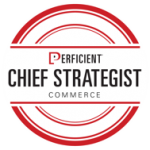Thrilling our clients with innovation and impact – it’s not just rhetoric. This belief is instrumental for our clients’ success. Earlier this year, we announced the first class of Chief Strategists, who provide vision and leadership to help our clients remain competitive. Get to know each of our strategists as they share their unique insights on their areas of expertise.
 In today’s digital landscape, businesses are always open. Creating rich, differentiated digital experiences is a “must” for a company’s long-term survival.
In today’s digital landscape, businesses are always open. Creating rich, differentiated digital experiences is a “must” for a company’s long-term survival.
However, the rapid pace of change in digital commerce creates a lot of confusion. Many companies struggle with staying current on trends to remain competitive and profitable. They aren’t aware of how to best take advantage of these technology shifts that provide better value to their business.
With 10 years at Perficient, Mike Rabbior, Commerce Chief Strategist, possesses deep expertise in nearly every business vertical and technical domain. One of his most notable career achievements includes helping to design and grow IBM’s industry-leading flagship commerce platform, WebSphere Commerce.
We recently spoke with Mike and learned more about his aspirations a Chief Strategist, his perspective on digital commerce, and his interests beyond the role of Chief Strategist.
 What does this new role as a Chief Strategist mean to you?
What does this new role as a Chief Strategist mean to you?
Mike Rabbior: It’s an opportunity for me to open our clients’ eyes to the art of the possible and what business transformation can mean for them. One of the best things about this job is serving as an outside view, seeing things in a different light, and providing value when our clients are too heads-down in the way they operate to see the potential.
What does your role as a Chief Strategist entail?
MR: I bring thought leadership to our [digital commerce] clients around helping them align with not just what their competitors and the industry is doing but also what’s happening with technologies. Which ones are best for them?
I spend time understanding a client’s environment, business needs, and goals. Then, I help the client [team] round the corners on their rough ideas – ones that might not be implemented right away or fully baked.
As a Chief Strategist, I like being that trusted advisor – a sage, if you will – who clients turn to and respect. It’s rewarding when clients seek you out because they believe you’re going to help them solve problems for which they don’t immediately see obvious answers.
That’s a unique aspect about Perficient. When clients leave our meetings, they walk away with insight, and they value the conversation because they leave knowing more than they did coming into it. That’s the greatest measure of success as a Chief Strategist.
What do you hope to learn as a Chief Strategist?
MR: It’s challenging to stay on top of everything because the technology is so vast and ever-changing. This role is a unique opportunity to be more heads up and less heads down, so I can actually see what the landscape has and how it’s shifting so rapidly. Being able to keep up with that to some degree is a bit of a blessing in this job.
Every discipline [at Perficient] has learned everything within its own field. So when you can bring thoughts from another discipline and make it relevant to you, it’s usually those Eureka moments where you can transform in ways that you wouldn’t within the narrow scope of just your own practice.
Strategically Speaking
Why does strategy matter for digital commerce businesses?
MR: It’s no longer an option for people not to have an eCommerce strategy. It’s an imperative just to do business.
Consider the way digital commerce has evolved from a little niche thing in the late ‘90s and early 2000s to the Amazon behemoth it is today. Digital business is the way of the present and the way of the future.
Any business that isn’t living and breathing this kind of commerce environment and how fast it evolves is really overwhelmed. The changes they make, or the strategies they execute are fundamental to their success or failure.
It doesn’t matter the size [of the business]. Billion dollar enterprises are going bankrupt because they failed to adapt. Unfortunately, a lot of existing businesses are at a major disadvantage because they own and operate so much technical debt. This presents a significant challenge and the need to build a strategy to stay competitive.
On the other end of the spectrum are startups, which are quick to get off the ground. But as soon as they are a little successful, they begin competing with consumers’ expectations of an Amazon experience. There’s a coming of age as they understand and recognize the need to build the right strategy to become a bigger player.
Why is strategy execution important for digital commerce businesses?
MR: The competitive landscape isn’t going to get less competitive. It’s going to get more so.
With the rapid pace of change, businesses can’t run the way they did for decades. I work with companies in a variety of industries, and have found that some haven’t really changed in the last 20 to 30 years. If they expect to survive, change is a must.
As I said earlier, strategy is an imperative. I can’t think of an industry or vertical that hasn’t already experienced disruption, and technology disruption will only continue. Businesses that are risk-averse or hesitant to change need someone like a Chief Strategy Officer – someone who’s going to make sure the company remains agile and will seize opportunities to stay competitive.
Which top three questions would you ask a client to inform its digital strategy?
MR: The first one is: “What is your number one challenge or inhibitor to growth?” That usually prompts thinking around areas where the business struggles the most, and why they are either failing to keep up or not recognizing the revenue potential. Regardless of the underlying reasons, it sets the backdrop for their motivation to change.
If the answer to the first question is too simple, I follow on with: “If you didn’t do anything, what would happen?” Then, you really get to the root of the problem – things like: “If we don’t transform, we’ll lose all the market share we have in this region.”
Following that question, the next one I ask is: “What are your competitors doing to solve this problem that you aren’t?” And then, “How can your business solve the problem in a way that your competitors can’t?”
These questions lead to very insightful conversations. More often than not, I can find a few suggestions of things the client may want to try, or point out things the client ought to start doing.
Every business has a competitive advantage. It just takes an outsider to see it and bring it forward for them.
What advice or tips do you have for developing a strategy?
MR: My biggest piece of advice is to not try and solve the problems you face today. Often when I see these kinds of strategies, businesses are only chasing their current issues. Instead, they need to take a step back, and dust off the complaints, criticisms, and stressors to get to the heart of the problem.
Because companies often have 27 challenges that can really be boiled down to two or three key pain points. When you alleviate those, it’s like a spider web, which flanges out and addresses several needs. Some of those that you didn’t even think were problems get resolved at the same time.
I’ve seen companies attempt to do strategy on their own, and they often get stuck in the mentality of: “This is the way we do it, and we’ll never change. We could never address that problem. It’s just too big.”
That’s when bringing in an outside perspective can help. You get that art of the possible conversation going, and the creative juices start to flow.
Think like a Chief Strategist
How does your team help clients on their digital transformation journey?
MR: We start by looking a company’s processes and seek to understand the objectives. It comes down to knowing who you are and where you want to head.
Clients are coming to us more often now and say, “We recognize we have deficiencies, but we also have goals. Help us connect the dots so we can understand how to get where we need to be.”
Or, when our clients don’t know what they want to be or should be, we help identify the underlying challenges. Then, we look at their current state – back-end systems, technology base, technical debt, and existing business processes. On top of this, we provide a strategic and visionary view and point out, “Here is what your industry looks like. Here’s where retail is going to be in 2020. Let’s help you build a map of where you are to get you where you need to be.”
One of my duties is to help clients realize that transformation takes time. As you go through this digital transformation journey, you want to be where the puck is going to be. You don’t want to be where the puck is.
Of the current complaints you have, some may disappear completely over the next three years. So rather than invest in your current problems, invest in some of the challenges you’ll have three years from now and actually leapfrog your competition.
Understand where your target is because it’s moving with you.
Tell us about a recent project you’ve tackled. How did we help the client achieve success?
MR: When we start client projects, one of the most exciting things is discovering quick wins to help clients transform. These are things that a business can do by connecting a few dots they just don’t see.
As an example, we worked with a large cooperative to implement a simple online catalog to use with its internal divisions. One of the executives, who needed to be involved, was unavailable to meet for the next 30 days.
Taken aback by this news, we asked where he would be for the next month, and the client replied, “He has to be at a buy mart.”
We replied, “What is a ‘buy mart,’ and what’s involved? Because we want to understand your business.”
We discovered that this is an event where all of the client’s distributors come and place their orders (for the quarter, a year?) Then, we asked the client why the executive would be unavailable for a whole month ahead of the buy mart. We learned that he was involved in making sure the catalogs were all printed, shipped, and delivered in plenty of time.
We simply looked at the team and said, “You have a digital version of the catalog now. Why wouldn’t you use tablets to access it during the event?”
After taking an hour to explain the concept, a member of the client team remarked, “Do you realize that’s going to save us $8 million a year in printing?”
This is a great example of that outsider’s perspective – being on the outside with your head up, understanding the art of the possible, and recommending a simple solution. It was of no additional cost to the client, other than thinking of how to implement a new tool in a different way.
Beyond the World of Strategy
What are your interests or hobbies when you’re not wearing the Chief Strategist hat?
MR: First and foremost, I’m a proud father of two. I coach a baseball team, and I’m a black belt sensei in the dojo. I also enjoy playing the guitar.
Much to my wife’s delight, I love home renovation. She’s usually has ongoing list of things she would like to improve in our house.
Follow along on this series to learn more about each of our Chief Strategists. And, take a look at recent blog posts they’ve written on trending topics for their industries.


Great questions to think of when creating a strategy! Thanks!